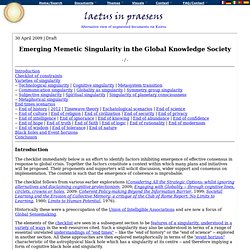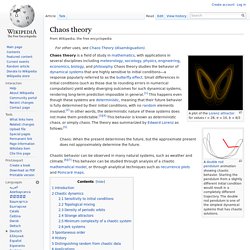The Singularity
We should learn everything we can about the Singularity
Earth911.com - Find Where and How to Recycle. Conspiracy Theories. Emerging Memetic Singularity in the Global Knowledge Society. 30 April 2009 | Draft.

Chaos theory. A double rod pendulum animation showing chaotic behavior.

Starting the pendulum from a slightly different initial condition would result in a completely different trajectory. The double rod pendulum is one of the simplest dynamical systems that has chaotic solutions. Chaos: When the present determines the future, but the approximate present does not approximately determine the future. Chaotic behavior can be observed in many natural systems, such as weather and climate.[6][7] This behavior can be studied through analysis of a chaotic mathematical model, or through analytical techniques such as recurrence plots and Poincaré maps.
Introduction[edit] Chaos theory concerns deterministic systems whose behavior can in principle be predicted.
Artificial Intelligence. Singularity-Emergence A.I.
Artificial Intelligence - Volume 1: Chatbot NetLogo Model. Produced for the book series "Artificial Intelligence"; Author: W.

J. Teahan; Publisher: Ventus Publishing Aps, Denmark. powered by NetLogo view/download model file: Chatbot.nlogo This model implements two basic chatbots - Liza and Harry.
Kurzweil Accelerating Intelligence. Artificial Intelligence. Technologies. Cyborg_x1. Humanoids. Robot Videos. Singularity Blog Covering Robots, Genetics, Stem Cells, Transhumanism, The Brain, The Future. BioDigital Human: Explore the Body in 3D!
Artificial Robotic Hand Transmits Feeling To Nerves. Astro Teller has an unusual way of starting a new project: He tries to kill it.

Teller is the head of X, formerly called Google X, the advanced technology lab of Alphabet. At X’s headquarters not far from the Googleplex in Mountain View, Calif., Teller leads a group of engineers, inventors, and designers devoted to futuristic “moonshot” projects like self-driving cars, delivery drones, and Internet-beaming balloons. To turn their wild ideas into reality, Teller and his team have developed a unique approach.
Science, Psychology & Philosophy. NANOBOTICS. Nanotechnology Basics. Home > Introduction > Nanotechnology Basics Nanotechnology Basics Last Updated: Friday, 14-Jun-2013 09:28:04 PDT What is Nanotechnology?

Answers differ depending on who you ask, and their background.
Covering technological, scientific, and cultural trends that are changing human beings in fundamental ways.
Michelle Ewens March 24, 2011 The concept of utility fog – flying, intercommunicating nanomachines that dynamically shape themselves into assorted configurations to serve various roles and execute multifarious tasks – was introduced by nanotech pioneer J.

Storrs Hall in 1993. Recently in H+ Magazine, Hall pointed out that swarm robots are the closest thing we have to utility fog. This brings the concept a little bit closer to reality.
Future humans with algae implants could breathe underwater. Why are past, present, and future our only options?
But things get awkward if you have a friend.

(Use your imagination if necessary.) Low blow, Dr. Dave.
Moore's law. Moore's law is the observation that, over the history of computing hardware, the number of transistors on integrated circuits doubles approximately every two years.

The law is named after Intel co-founder Gordon E. Moore, who described the trend in his 1965 paper.[1][2][3] His prediction has proven to be accurate, in part because the law is now used in the semiconductor industry to guide long-term planning and to set targets for research and development.[4] The capabilities of many digital electronic devices are strongly linked to Moore's law: processing speed, memory capacity, sensors and even the number and size of pixels in digital cameras.[5] All of these are improving at roughly exponential rates as well.
This exponential improvement has dramatically enhanced the impact of digital electronics in nearly every segment of the world economy.[6] Moore's law describes a driving force of technological and social change in the late 20th and early 21st centuries.[7][8] History[edit]
Institute for Ethics and Emerging Technologies. Infographic - The Emergence of Collective Intelligence. Technological Singularity. The technological singularity is the hypothesis that accelerating progress in technologies will cause a runaway effect wherein artificial intelligence will exceed human intellectual capacity and control, thus radically changing civilization in an event called the singularity.[1] Because the capabilities of such an intelligence may be impossible for a human to comprehend, the technological singularity is an occurrence beyond which events may become unpredictable, unfavorable, or even unfathomable.[2] The first use of the term "singularity" in this context was by mathematician John von Neumann.

Proponents of the singularity typically postulate an "intelligence explosion",[5][6] where superintelligences design successive generations of increasingly powerful minds, that might occur very quickly and might not stop until the agent's cognitive abilities greatly surpass that of any human. Basic concepts Superintelligence Non-AI singularity Intelligence explosion Exponential growth.
Computers: Artificial Life: Artificial Worlds. The Emergence of Collective Intelligence. TOP TEN UNSOLVED PROBLEMS IN PHYSICS. List of fallacies. A fallacy is incorrect argument in logic and rhetoric resulting in a lack of validity, or more generally, a lack of soundness.

Fallacies are either formal fallacies or informal fallacies. Formal fallacies[edit] Main article: Formal fallacy. List of memory biases.
.bodycard 1349










